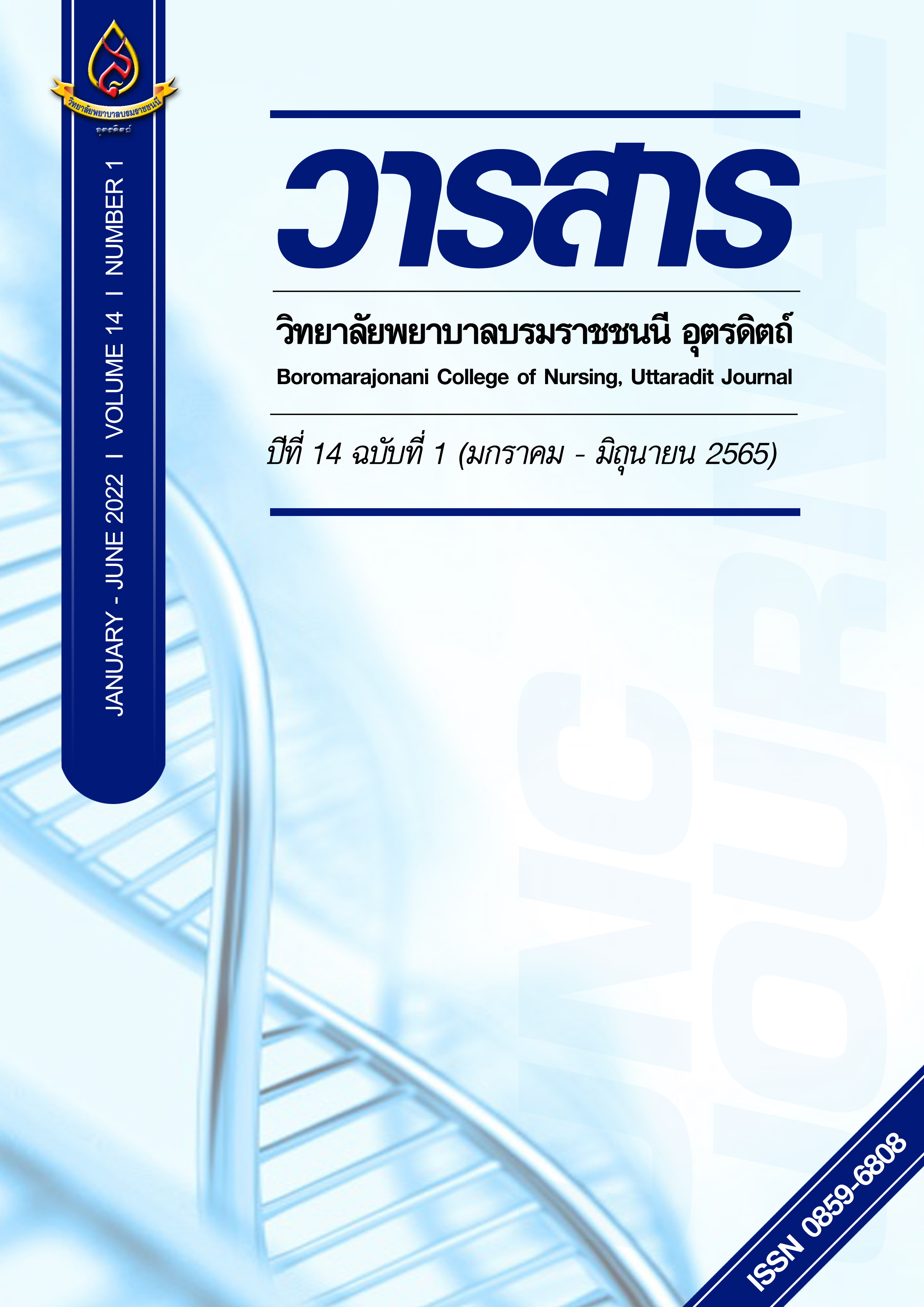การออกกำลังกายแบบฝึกกล้ามเนื้อเพื่อป้องกันการเกิดกลุ่มอาการผิดปกติ ทางโครงร่างกล้ามเนื้อจากการทำงาน
Main Article Content
บทคัดย่อ
กลุ่มอาการผิดปกติทางโครงร่างกล้ามเนื้อจากการทำงาน เป็นปัญหาสุขภาพที่พบได้มากในหลายประเทศทั่วโลกรวมถึงประเทศไทย ส่งผลต่อคุณภาพชีวิต ความสามารถและประสิทธิภาพในการทำงานของคนทำงานมากที่สุด ซึ่งการออกกำลังกายเป็นกิจกรรมหนึ่งที่พบว่าสามารถป้องกันการเกิดกลุ่มอาการผิดปกติทางโครงร่างกล้ามเนื้อได้ การออกกำลังกายแบบฝึกกล้ามเนื้อ เป็นรูปแบบการออกกำลังกายวิธีหนึ่งที่สามารถทำได้ง่าย ใช้เวลาไม่มาก และทำได้ทั้งในที่ทำงานหรือที่บ้าน มีผลต่อการเพิ่มมวลและความแข็งแรงของกล้ามเนื้อ ลดอาการปวดกล้ามเนื้อ และช่วยป้องกันการเกิดกลุ่มอาการผิดปกติทางโครงร่างกล้ามเนื้อได้ ในบทความนี้ได้นำเสนอรูปแบบการฝึกกล้ามเนื้อแต่ละกลุ่มของร่างกาย และการออกกำลังกายแบบมณีเวช ที่สามารถนำมาใช้ในการป้องกันการเกิดกลุ่มอาการผิดปกติทางโครงร่างกล้ามเนื้อจากการทำงาน
Article Details

อนุญาตภายใต้เงื่อนไข Creative Commons Attribution-NonCommercial-NoDerivatives 4.0 International License.
บทความหรือข้อคิดเห็นใดใดที่ปรากฏในวารสารวิจัยการพยาบาลและวิทยาศาสตร์สุขภาพ เป็นวรรณกรรมของผู้เขียน ซึ่งบรรณาธิการหรือสมาคมศิษย์เก่า ไม่จำเป็นต้องเห็นด้วย และบทความที่ได้รับการตีพิมพ์เผยแพร่ถือเป็นลิขสิทธิ์ของวารสารวิจัยการพยาบาลและวิทยาศาสตร์สุขภาพ
เอกสารอ้างอิง
Badley, E. M., Rasooly, I., & Webster, G. K. (1994). Relative importance of musculoskeletal disorders as a cause of chronic health problems, disability, and health care utilization: findings from the 1990 Ontario Health Survey. The Journal of rheumatology, 21(3), 505–514.
Bureau of Occupational and Environmental Diseases. (2018). Annual report 2017. Retrieved from http://envocc.ddc.moph.go.th/uploads/situation2/2561/2561_01_envocc_situation.pdf (in Thai).
Cairns, S. P. (2006). Lactic acid and exercise performance. Sports medicine, 36(4), 279-291.
Caspersen, C. J., Powell, K. E., & Christenson, G. M. (1985). Physical activity, exercise, and physical fitness: definitions and distinctions for health-related research. Public Health Reports, 100(2), 126-131.
Centers for Disease Control and Prevention. (2015). Physical activity and health. Retrieved from http://www.cdc.gov/physicalactivity/basics/pa-health/index.htm
Chaisurin, P., Moongtui, W., Kaewthummanukul, T., & Stapornpat, P. (2012a). Work-related musculoskeletal disorders and related factors among professional nurses in surgical division, tertiary care hospital. Nursing Journal, 39(special), 46-61. (in Thai).
Chaiyodsilp, S. (2012). Strength training. Retrieved from http://visitdrsant.blogspot.com/2012/10/strength-training.html. (in Thai).
da Costa, B. R., & Vieira, E. R. (2008). Stretching to reduce work-related musculoskeletal disorders: a systematic review. Journal of rehabilitation medicine, 40(5), 321–328.
de Freitas-Swerts, F. C. T., & Robazzi, M. (2014). The effects of compensatory workplace exercises to reduce work-related stress and musculoskeletal pain. Revista Latino-Americana de Enfermagem, 22(4), 629-636.
Department of physical education. (2018). Stretching-Book. Retrieved from https://www.dpe.go.th/dwl-files-401891791937 (in Thai)
Dindem, N. (2019). The effect of ergonomic self–care enhancement with Maneevej exercise program on lower back pain and functional ability in operating room nurses. (Master’s thesis). Prince of Sonkla University, Sonkla, Thailand. Retrieved from https://kb.psu.ac.th/psukb/bitstream/2016/12605/1/437567.pdf (in Thai)
Gartley, R. M., & Prosser, J. L. (2011). Stretching to prevent musculoskeletal injuries. An approach to workplace wellness. AAOHN journal: official journal of the American Association of Occupational Health Nurses, 59(6), 247–252.
Gasibat, Q., Simbak, N. B., Aziz, A., Petridis, L., & Tróznai, Z. J. A. (2017). Stretching exercises to prevent work-related musculoskeletal disorders: A review article. American Journal of Sports Science and Medicine. 2017, 5(2), 27-37.
Health and Safety Executive. (2021). Work related musculoskeletal disorder (WRMSDs) statistics, great britain 2021. Retrieved from https://www.hse.gov.uk/statistics/causdis/msd.pdf
Lahti, J., Laaksonen, M., Lahelma, E., & Rahkonen, O. (2010). The impact of physical activity on sickness absence. Scandinavian journal of medicine & science in sports, 20(2), 191-199.
Magnusson, S. P., Simonsen, E. B., Aagaard, P., Dyhre-Poulsen, P., McHugh, M. P., & Kjaer, M. (1996). Mechanical and physical responses to stretching with and without preisometric contraction in human skeletal muscle. Archives of physical medicine and rehabilitation, 77(4), 373–378.
Mooney, V., Kron, M., Rummerfield, P., Holmes, B. (1995). The effect of workplace based strengthening on low back injury rates: A case study in the strip mining industry. The Journal of Occupational Rehabilitation, 5(3), 157-167.
Moore T. M. (1998). A workplace stretching program. Physiologic and perception measurements before and after participation. AAOHN journal: official journal of the American Association of Occupational Health Nurses, 46(12), 563–568.
Morken, T., Magerøy, N., & Moen, B. E. (2007). Physical activity is associated with a low prevalence of musculoskeletal disorders in the Royal Norwegian Navy: a cross sectional study. BMC musculoskeletal disorders, 8, 56.
Ningsanond, N. (2011). Simple way to make life easier…by Maneeveda. Journal of Srinakharinwirot University (Journal of Science and Technology), 3(5), 1-13.
NIOSH. (1997). Musculoskeletal disorders and workplace factors: A critical review of epidemiologic evidence for work-related musculoskeletal disorders of the neck, upper extremity, and low back. Retrieved from http://www.cdc.gov/niosh/ergosci1.html
Punnett, L., & Wegman, D. H. (2004). Work-related musculoskeletal disorders: the epidemiologic evidence and the debate. Journal of electromyography and kinesiology: official journal of the International Society of Electrophysiological Kinesiology, 14(1), 13–23.
Schultz, A. B., & Edington, D. W. (2007). Employee health and presenteeism: a systematic review. Journal of occupational rehabilitation, 17(3), 547-579.
Shuval, K., & Donchin, M. (2005). Prevalence of upper extremity musculoskeletal symptoms and ergonomic risk factors at a Hi-Tech company in Israel. International journal of industrial ergonomics, 35(6), 569-581.
Social security office. (2021). Annual report 2021. Retrieved from https://www.sso.go.th/wpr/assets/upload/files_storage/sso_th/5ebe42693bf27ca62 4d2a14a89f99223.pdf. (in Thai).
Sungwan, P., Thathong, P., & Muenchan, L. J. T. R. C. N. J. (2021). An effect of Maneevej exercise to office syndrome among office worker of university. Thai Red Cross Nursing Journal, 14(2), 251-263. (in Thai).
Tangkitwanitch, W., & Sirasaporn, P. (2020). Modified prasit Thai upper extremities exercise (Maneeveda) 4 postures combined with ergonomic adaptation for result to relief neck and shoulder pain in Nongkhai hospital personnel. Udonthani Hospital Medical Journal, 28(2), 232-243. (in Thai).
Vieira, E., Kumar, S., & Narayan, Y. (2008). Smoking, no-exercise, overweight and low back disorder in welders and nurses. International Journal of Industrial Ergonomics, 38(2), 143-149.
Weinstein, S., Yelin, E., & Initiative, U. S. B. a. J. (2015). The burden of nusculoskeletal diseases in the United States. Retrieved from
https://www.boneandjointburden.org/docs/The%20Burden%20of%20Musculoskel etal%20Diseases%20in%20the%20United%20States%20(BMUS)%203rd%20Edition%20(Dated%2012.31.16).pdf
World Health Organization. (2016). Global recommendations on physical activity for health. Retrieved from http://www.who.int/dietphysicalactivity/factsheet_recommendations/en/


